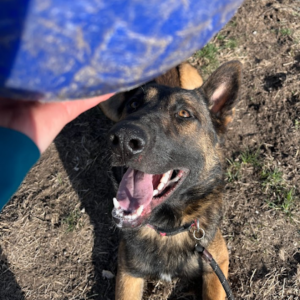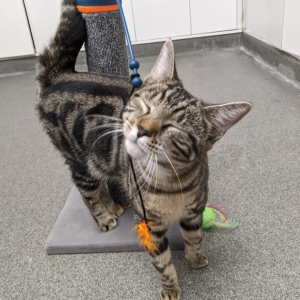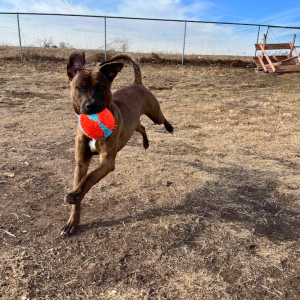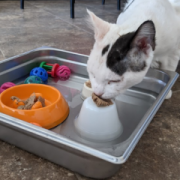April 23, 2024 –
Written by NOCO Humane’s Weld Campus Behavior Team: Kiyoka Tamesue, PSM, KPA-CTP and Julia Pinckney, MSc.
If you’re an animal lover, you’ve likely heard or seen the term “enrichment” in the context of animal welfare; but what exactly is enrichment, and how can we use it to improve the lives of the animals we love and care for?
Enrichment is anything that “enriches” or improves an animal’s life and allows them to express natural behaviors in a way they find mentally and physically stimulating. Providing enrichment reduces frustration, boredom, and environmental stress, which contribute directly or indirectly to behavioral, physical, and mental health problems.
Enrichment affords your pet choice and control by allowing them to interact with their environment on their own terms, and allows them to use their bodies, minds, and senses to connect with their social or environmental surroundings.

WHAT COUNTS AS ENRICHMENT?
Anything that an animal finds, well…enriching, counts as enrichment! The possibilities for fun and interactive enrichment options are virtually endless, and can include anything from daily walks or “sniffaris,” to Kongs and scented toys. Enrichment comes in many forms and is most effective when it meets the specific needs of a species and/or individual animal, and helps promote healthy, natural behaviors.
It is important (and fun!) to provide our animal friends with new and exciting enrichment that changes from day to day. Imagine finding the exact same crossword puzzle in the Sunday paper week after week. You would lose interest pretty quickly and it would no longer be fun or mentally engaging. Animals feel the same way, so mix it up and keep your best friend’s enrichment new and exciting!
SOME EXAMPLES OF ENRICHMENT
What we use in the shelter
Different types of play, new toys, interesting smells, textures, and surroundings are all forms of enrichment. At NOCO Humane, we give each and every animal in our care multiple forms of enrichment each day. Here are some examples:
- Dogs enjoy Kongs or other food-dispensing toys stuffed with kibble and wet food, which they have to lick, chew, paw, and nose to get the food out of.
PRO-TIPS:
- Freezing Kongs and puzzle feeders creates a longer-lasting, more challenging experience!
- Our pets find it fun to work for their food, so giving them a portion, or all, of their meal in a puzzle toy or Kong can make feeding more enjoyable and longer-lasting.
- When using puzzle toys and other forms of enrichment that engage problem solving skills, start easy, then gradually increase the difficulty as your pet’s skills improve. Puzzles or Kongs that are too hard to get goodies out of right away can cause feelings of frustration and defeat.
- Cats’ hearing is about three times more sensitive than humans’, so playing calming classical music, nature sounds, or white noise can reduce stress by drowning out background noise. Some research has shown that certain types of music can be calming and help create a sense of wellbeing – find the genre or style that works best for your pet.
- In the shelter, we use white noise machines in cat and rooms to reduce stress inducing background noises like barking and human activity
- Small mammals, like guinea pigs and rabbits, get a kick out of toilet paper tubes stuffed with hay and treats, which they have to nudge, toss, and tug snacks out of.
- Scent enrichment can be enjoyed by all animals. At the shelter, we spritz small amounts of specially mixed, pet-safe essential oils and animal scents on cloth or stuffed toys for the smelling pleasure of our animal friends.

PRO-TIP: Sprays like Adaptil and Feliway contain calming pheromones like those produced by mothers after their puppies or kittens are born. Spraying these on blankets and other items can promote a sense of calm and comfort.
Ideas for a home environment
You are likely already providing your pets with various types of enrichment at home each day, whether it’s by taking your dog(s) on a walk or providing your furry (or not so furry) friend with fun toys, play, and affection.
We encourage you to get creative with your enrichment ideas and have fun coming up with unique and exciting ways to expand your pet’s (and your own) world!
When deciding which types of enrichment would be best for your animal(s), consider their individual needs, personality, and species. Not all types of enrichment will be suitable for all animals. For example, a dog that’s nervous around new people won’t benefit from being taken to your favorite brewery during happy hour. Ask yourself, “What will my pet enjoy most? What kinds of activities will encourage natural behaviors? How will this help engage their senses?”
Here are some ideas:
- Travel to the dog park (provided your dog is happy around other canine friends of course!)
- A “sniffari”- Not your typical daily walk, but outdoor time to sniff around and explore at your pet’s pace
- A one-on-one visit with a new person or pet friend
- Extra snuggle or play time
- New toys (plushy, chewy, electronic, wand toys, textured, etc.)
- Rotating interactive feeder toys
- Creating your own interactive feeder toys
- Playing “cat TV,” “dog TV,” etc. on YouTube
- Pheromone sprays or diffusers
- Snuffle mats or lick mats
- Pupsicles
- A training session
- A new bed, hiding spot, perch, or comfy space
- Cracking a window to allow the smells and sounds of the outdoors to drift in
- For caged animals, rotating the location of toys, hides, chews, etc.

When trying a new form of enrichment, always supervise your pet for safety and comfort.
SET GOALS FOR YOUR PET’S ENRICHMENT TODAY!
Making and giving your animal daily enrichment is a great way to bond with your pet, and can be a really fun and creative family activity. It doesn’t have to take a long time, cost money, or be too involved. Try some of the above activities, or get inspiration from the resources below.
Setting goals to provide a certain number of enrichment activities per week for each of your pets is an excellent way to start your journey, and to experience how much an enrichment routine can improve your animals’ health and happiness!
Additional resources:
Homemade or bought food puzzles for cats: http://foodpuzzlesforcats.com/
DIY dog enrichment: https://www.aspca.org/pet-care/dog-care/canine-diy-enrichment
Treat lasagna: https://youtu.be/wgQTb2UYPs0



